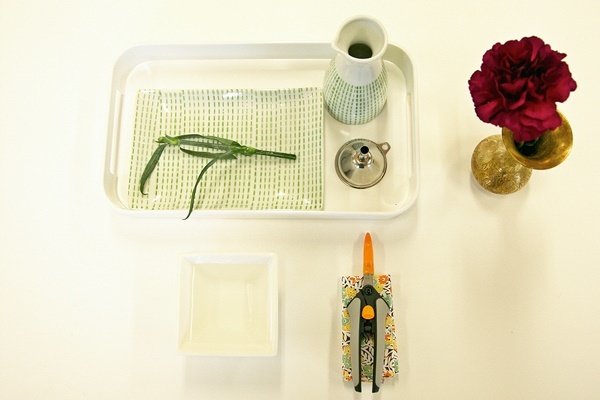
Mise en Place
For anyone who has worked in a bustling commercial kitchen (or who enjoys watching the myriad cooking shows on TV), preparation and organization are key to maintaining order and preventing chaos. The French term mise en place (“put in place”) means all ingredients and tools are gathered and arranged before cooking takes place, thus paving the way for smooth execution of the dish.
NPR ran a story today called The Science of Getting Kids Organized about high schoolers whose parents are hiring coaches (at significant expense) to help them garner the mental and physical skills of organization. According to the article, “Executive function coaching has emerged from a booming interest in all things neuroscience, especially in education. But no one is policing claims of the field or setting standards for what individual coaches do.”
Executive function skills are also emerging as a big deal in early learning circles. Wikipedia defines Executive Functions (also known as cognitive control and supervisory attentional system) as an “umbrella term for the management (regulation, control) of cognitive processes, including working memory, reasoning, flexibility, and problem solving as well as planning and execution.” Numerous longitudinal studies have proven that the preschool-aged children who demonstrate greater executive function skills such as inhibitory control, working memory, and cognitive flexibility not only have better academic outcomes, they tend to have healthier interpersonal relationships as well. It makes sense that children who have had many years of practice honing those “EF” skills will be confident, independent, and fully prepared adults.
So how do we scaffold the formation of EF skills for the young child in an early learning setting? Most visitors to a Montessori environment come away impressed by the beauty and serenity, the furnishings and activities made of natural materials, and the busy hum of independent activity among the mixed-age group of children. A common question expressed by prospective parents who come to observe is, “What’s controlling all this? How are the children so independent and focused?”
Getting back to our cooking analogy, mise en place is a very apropos concept for the way the Montessori classroom and the individual activities therein are prepared. The preparation runs much deeper than what meets the initial glance. Young children are able to engage in independent activity through the way the activities themselves are organized. Here is how the children experience “mise en place” in Montessori:
- The teacher has mindfully prepared the environment with beautiful, purposeful, real materials easily used by child-sized hands. Every tray, basket, scissor, pitcher, etc. must meet these criteria or will not be serviceable to the child.
- Children are introduced to each activity by their teacher, including the choosing, doing, and putting away (also known as the three-part work cycle). The teacher is mindful to demonstrate the analyzed movements and sequence with precision to provide the child the clearest, best model possible for the child’s own successful independent activity. No detail is too small, from the way in which the teacher arranges the items on the table or work rug in accordance with the sequence of use, to the slow, graceful demonstration of the movements themselves. These refined movements engage the child’s interest and provide a clear, indelible impression to scaffold their successful independent activity.
- The areas of activity are grouped logically (i.e., the math activities are all in the math area), and each individual activity has its own discrete, designated spot. (“A place for everything, and everything in its place.”)
- The “units of work” are prepared and ready to take off the shelf. For example, if a child were to choose table scrubbing, everything he will need for this activity will be contained on a child-sized tray: the soap in its dish, the scrub brush, underlay, etc.—all will be at the ready. It will also help him return the items in the ready-to-use way back to the tray, and the tray back to the shelf for the next child’s use.
- Furthermore, the items are color-coded to help promote functional independence and support the young child’s developing mental, internal order. She knows without being told that the blue glass bottle, blue dish, blue underlay, and blue cloths on the tray with blue trim all belong to the brass-polishing work.
- Because the child has been thoroughly oriented to the room, and because all items within it are accessible to her, she knows exactly where to find what she needs: the aprons, the sink, the spill cloths, the compost bin…which in turn enables her to function with independence.
Just like the chef who has everything prepared and within reach, the child is similarly supported through the mise en place of the classroom to engage in joyful, independent activity, building up an internal sense of order, logical thinking, memory training, and capacity for increasingly complex sequences of activity, repeating these activities until she achieves self-satisfaction.
With any luck, mom or dad won’t need to hire an expensive Executive Function coach to get homework turned in on time by the time she hits high school. In the words of the chef Jacques Pepin, “You have no choice as a professional chef: you have to repeat, repeat, repeat, repeat until it becomes part of yourself.” Dr. Montessori agreed—she wrote in The Secret of Childhood, “Repetition is the secret of perfection.”
Happy “cooking”!

Beatae similique omnis qui enim alias laudantium! Voluptatum totam iure expedita, id natus, repellendus accusantium dolore suscipit mollitia quos consequatur. Sapiente optio, adipisci totam nostrum pariatur quisquam labore id.
Ratione, illo possimus fugit voluptates rem error excepturi aspernatur odit pariatur, eius ex et neque esse aut quas, sapiente? Quo quaerat est error nam, necessitatibus placeat consequatur dicta quam nobis ipsa delectus adipisci esse assumenda doloremque dignissimos tempora deleniti doloribus ducimus aperiam dolor labore excepturi ipsum odio. Minus vel itaque unde autem debitis corporis, soluta rem! Aperiam reiciendis at deleniti tempore, sit quasi.
